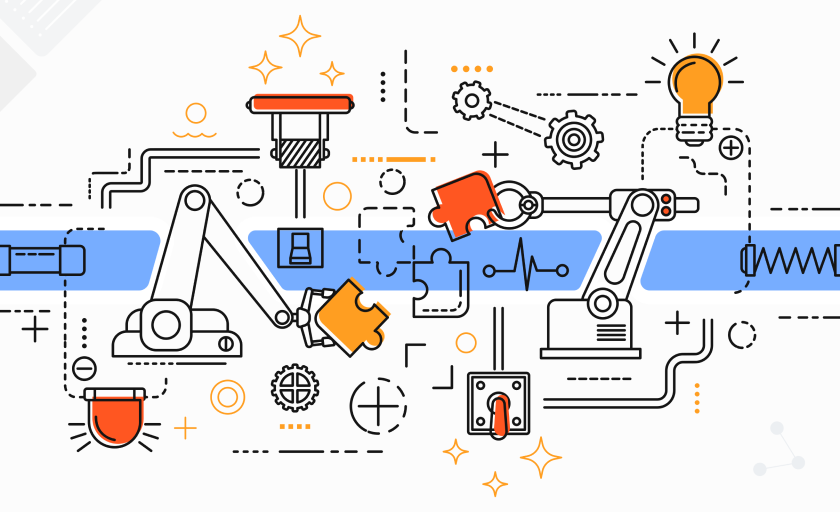
With the manufacturing industry's market size reaching $8.8 trillion in 2022, it becomes crucial for companies to adopt new technologies and modernize the software they are using. In this article, we focused on the importance of software modernization in manufacturing industry and touched upon its advantages for improving operational efficiency.
By modernizing their software, traditional one-product manufacturers and large companies can cut operational costs, alleviate security issues, and harness the full potential of technological advancements.
Benefits of Software Modernization in the Manufacturing Industry
The manufacturing industry undergoes transformation, influenced by innovative concepts like the Internet of Things and Artificial Intelligence. Emerging digital technologies enable manufacturers to optimize production by upgrading their legacy systems. Digital transformation also involves collecting data from different machines and pieces of equipment.
Read on if you are wondering how to scale up your business, reduce time-to-market, lower staff expenses, and minimize the software and hardware maintenance and running costs. Below, we will briefly outline the key advantages of software modernization in manufacturing sector.
Streamlined Data Collection
Why is modernization in manufacturing sector essential? Modern businesses increasingly rely on data. And digital transformation enables companies to store their data in a centralized way. Due to this, they can collect information automatically and get detailed reports. As a result, manufacturers can optimize their production processes and reach their business goals by tracking key performance indicators.
Using smart sensors to collect data from the machines and equipment, manufacturers predict possible issues and perform predictive maintenance to reduce downtime.
Modernization in manufacturing industry allows companies to get real-time data on the production processes and supply chain issues. Companies can track inventory levels, learn about demand cycles, and get delivery updates. It allows them to control the production volume more effectively.
Efficient Workforce Management
Modernizing a software in manufacturing business involves optimizing production processes. Since workers can access data from different platforms, they can divide their responsibilities and collaborate better. In addition, it allows companies to complete projects with fewer staff members.
Architecture Patterns for Intra-Factory Connection
Companies need to connect different manufacturing processes digitally to optimize their workflow, increase revenue, and improve the KPI of individual employees. Modernization in manufacturing allows them to create projects to establish a connection within a single factory or between different factories. Intra-factory connectivity prioritizes establishing a connection between areas. It facilitates information exchange by automating tasks at different levels. There are 4 main manufacturing areas:
5 Top Examples of Software Modernization in Manufacturing Business
To find out which solution suits their business needs the most, companies need to analyze examples of software modernization in manufacturing. Below, we have briefly described the main cases of software modernization that allow manufacturing businesses to manage their operations better
#1ERP Manufacturing Software
ERP stands for Enterprise Resource Planning. This term describes software products that help companies manage their inventory, supply chain operations, and other tasks. Businesses also use them to assess and mitigate risks.
ERP solutions allow businesses to make their operations more efficient and facilitate access to critical information. These programs are a crucial part of IT modernization in manufacturing as they are perfect for updating and managing an inventory. Manufacturing and construction companies, educational institutions, and businesses from other industries use ERP software.
If you are on a tight budget, it might be daunting to set up and use ERP software. Such solutions are of great value to large, well-established companies.
#2CMMS Software for Manufacturing
CMSS, or a Computerized Maintenance Management System, encompasses a range of solutions that make maintenance services highly efficient by centralizing information. Using such software, companies optimize their workflows and automate repeating tasks. CMMS products enable teams to understand which preventive maintenance services they need to provide. After modernizing a software in manufacturing, technicians will know which tools they need to complete every step of the maintenance procedure.
CMMS products allow companies to make the most of their physical assets, including the available vehicles and infrastructure. It enables them to make their operations more productive and minimize expenses.
It might be too expensive to set up and use an on-premise CMMS if your budget is limited. At the same time, some cloud-based CMMS solutions might be too expensive if you decide to adjust them to your liking. In addition, you might face some compatibility issues when trying to integrate them with other platforms.
#3Computer-Aided Manufacturing Software
CAM systems typically include computer-aided manufacturing programs and devices controlled with the help of computers, such as 3D printers, milling machines, or laser cutters. CAM software enables you to get ready-made products using designs with toolpaths. Companies that produce air-conditioning and refrigeration devices, and those specializing in electrical, mechanical, and aerospace engineering can hugely benefit from using CAM systems.
After setting up a CAM system, you don’t need to control every step, as it will run the processes automatically.
CAM solutions are costly and require companies to hire highly-skilled professionals.
#4Computer-Aided Design Software for Manufacturing
CAD solutions are perfectly suitable for software modernization in manufacturing business as they enable teams to create 2D and 3D designs of the highest quality. Using it, your team will get access to detailed documentation. Such programs are used by companies specializing in civil and structural manufacturing, consumer products, and medical devices. CAD solutions are utilized by companies from the oil and gas industries as well.
CAD software allows companies to implement their ideas, optimize communication between teams, and optimize workflows. Using CAD tools, engineers can detect possible issues with the manufacturing process.
CAD systems are expensive. In addition, companies need to allocate additional funds to train their employees.
#5EHS Software for Manufacturing
EHS stands for environment, health, and safety. Such programs have extensive toolsets and enable businesses to comply with the existing regulations. By modernizing a software in manufacturing industry, companies can improve their safety procedures as well as manage environmental and other risks. EHS programs are a must for businesses that create reports on environmental, health, and safety issues.
EHS solutions allow companies to make fact-based decisions to improve safety.
Relying on EHS software, teams get few opportunities to interact and build trust or engage in hands-on learning.
Challenges of Software Modernization in the Manufacturing Sector
Companies that want to scale up their operations might face various challenges with getting quality leads, increasing their revenue, and providing continuous maintenance. Businesses that invest in manufacturing modernization often need help selecting suitable software and modernizing the programs they use.
As there are many solutions on the market, you can narrow down the selection by opting for software relevant to your industry. A more cost-efficient solution would be to choose a program that can be customized to suit your needs. If you don’t know which software suits your needs best, you can install a trial version to see whether the program allows you to work with large chunks of data. The data should be clear and allow you to understand the development processes well to make it easier to implement new ideas.
There is no need to decide at once which program to choose Integrio System will help you with predictive maintenance, employee productivity optimization, and expense reduction. We can also minimize production risks and improve manufacturing processes using AI-driven tools. Reach out to our team if you need professional assistance overcoming the challenges of manufacturing software modernization.
Consider Integrio Your Trusted Partner
Integrio Systems provides custom manufacturing software development services for those who aren’t satisfied with all-in-one solutions. If you are interested in modernization in manufacturing business, take a closer look at the solutions offered by our team.
We build custom software from scratch to assist companies with boosting their performance, improving the efficiency of employees, minimizing the risk of human mistakes, and meeting the latest safety and performance regulations. We have experienced teams based in Canada, Poland, and Ukraine. On our website, you can also learn more about how to modernize legacy systems using the services provided by our professionals.

Manufacturing Modernization Case Study: Cam Tran
In 2014, a Canadian company Cam Tran known for its high level of expertise in manufacturing, repairing, and renewing oil-filled distribution transformers, was looking for a trusted partner for building a custom app with in-built work instruction management tools.
As a result of our cooperation, Integrio Systems created a custom software called Jive. It facilitates creating, storing, editing, and viewing work instructions. Using the in-built tools, teams can search for files and organize them to their liking.
After completing the initial project, Integrio helped Cam Tran optimize their production cycle by automating tasks. We turned Jive into a full-fledged ERP system with an extensive production and inventory management toolkit for advanced control over the manufacturing process.
In addition, Jive has in-built quality control and project management tools. Companies can use it for storing their documents securely, conducting audits, and optimizing schedules.
Get in touch with Integrio Systems if you want to modernize manufacturing software or build custom solutions from scratch.




